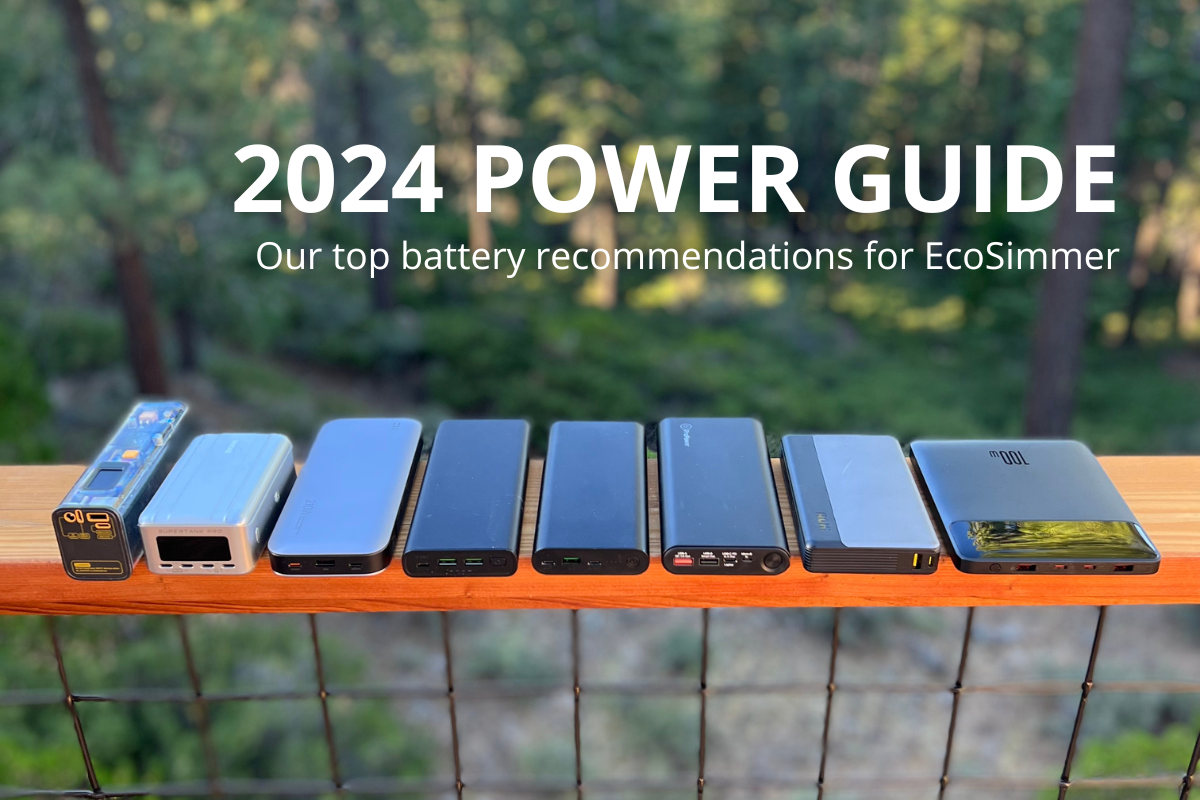Backcountry electric cooking with EcoSimmer requires 100-140W USB-C power
Before diving in, there are 3 key considerations for choosing the right power source to use with EcoSimmer:
Step 1: Decide if a battery is the right solution for your use case (vs power station, AC or DC adapter)
For backpacking, portable batteries are required, whereas for car camping, road tripping, emergency preparation, and more, power stations or AC and DC adapters can be used to power EcoSimmer. Since batteries can be used for any application, this guide will help you choose the right battery for your EcoSimmer electric backpacking stove.
Step 2: Find a compatible USB-C power source that outputs 100W or 140W on a single port
It's essential to check for the correct specifications since USB-C sources can vary in output (i.e., 45W, 65W, etc.). However, any lower than 100W is not enough to power your EcoSimmer.
You can get 140W or 100W USB-C power sources in the form of USB-C batteries and AC adapters (for wall outlets) and DC adapters (for car charging via cigarette lighter ports). Larger battery based power generators and solar generators can also be used, either supporting native 100W or 140W USB-C ports, or with use of the AC and DC adapters. DC adapters work great at 100W, but since most auto DC ports support 12V 10A (120W), they are best used with 100W USB-C DC adapters only. In general, the type of USB-C power source you use is related to how you will use EcoSimmer.
If you are backpacking and weight and space is optimized, then a USB-C battery of around 100Wh capacity is a good choice. If you are camping, then a similar battery works great, as well as a setup with a larger battery based power generator or solar generator. If using at home, then an AC outlet might be the most convenient.
Step 3: Make sure your USB-C cable is compatible too
Like batteries, not all USB-C cables support 140W or 100W of power transfer. The good news is each EcoSimmer backpacking stove comes with a compatible 140W or 100W USB-C cable that is clearly marked. A cable that supports 100W or 140W will be marked 240W (that is the way they are produced) and a cable that supports only 100W and lower will be marked 100W. Cables without those markings likely will not be able to be used with EcoSimmer. So all you need to worry about is finding a compatible battery–and we’re here to help!
Our EcoSimmer branded USB-C cable has the EcoSimmer logo and clearly states 100W on both ends. This way, you can’t accidentally mix it up with another cable, and you’ll know it’ll work with your EcoSimmer.
Batteries: Our Favorites
We have tested most 140W and 100W USB-C batteries on the market, so you don't have to. Each battery varies in price and features, which can impact how well it performs and for which activities it's suitable.
See below for our comparison of EcoSimmer's compatible batteries and shortlisted each one's most relevant specs. With a combination of form and function, the following are our favorite batteries to use with EcoSimmer (in order):
Our Top 5 Favorite Battery Recommendations
| 100W Battery | Price (USD) | Weight (Ounces) | Dimensions (Inches) | Battery Capacity (Wh) | Max Single-Port Output (W) |
| Anker 737 | $149.99 | 22.2 | 6.1 x 2.2 x 2.0 | 86.4 | 140 |
| Anker Prime 27,650mAh | $179.99 | 23.5 | 6.4 x 2.0 x 2.2 | 99.5 | 140 |
| INIU B64 140W | $99.99 | 21.9 | 7.8 x 4.0 x 1.2 | 97.2 | 140 |
| Baseus Adaman 140 | $99.99 | 17.3 | 5.4 x 3.3 x 1.2 | 86.4 | 140 |
| AOHI 30000MAH | $99.99 | 18.7 | 6.0 x 3.5 x 1.0 | 100 | 100 |
The Runners Up
| 100W Battery | Price (USD) | Weight (Ounces) | Dimensions (Inches) | Battery Capacity (Wh) | Max Single-Port Output (W) |
| Anker 747 | $149.99 | 19 | 7.2 x 3.2 x 0.9 | 94.7 | 140 |
| Amegat 140 | $69.99 | 22.5 | 6.1 x 2.1 x 2.0 | 88.6 | 140 |
| ZMI PowerPack | $159.00 | 20.5 | 7.4 x 3.2 x 1.1 | 90.8 | 100 |
| Baseus Blade | $99.99 | 17.3 | 6.4 x 5.3 x .1 | 74 | 100 |
| Shargeek 100 | $229.99 | 20 | 5.9 x 2.3 x 1.8 | 93.5 | 100 |
| Zendure Supertank Pro | $169.99 | 20 | 4.9 x 2.9 x 1.9 | 99.2 | 100 |
Notes:
- Battery prices as of 3/26/24.
- Battery Capacity is a reflection of how much energy the battery stores. Shown here in Watt-hours (Wh), but this is also commonly displayed in/correlated to milliampere hours (mAh).
Battery Reviews: Our Top 5
#1 | Anker 737 — Name Brand with Detailed Readout Display (our 140W workhorse)

Summary: The Anker 737 Power Bank is has been the workhorse 140W and 100W battery for us for 140W as well as 100W. Support for both power and a very detailed LED display make it easy to use and be constantly in the know on both charge capacity and power draw while in use. From the World's #1 charging brand, it's dependable, reliable, and effective.
Pros:
- x2 USB-C outputs
- Supports 140W and 100W
- High quality build for durability
- Detailed LED display that shows charge remaining to the %, battery temperature, input and output, and so much more!
- Competitive price for its capacity
- Often on sale (as much as 30-40% off!)
Cons:
- Slightly more expensive for capacity than some alternatives
- USB-C ports cannot simultaneously support powering EcoSimmer and an additional output at the same time
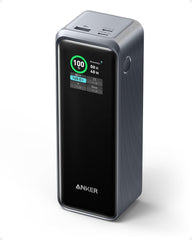
#2 | Anker Prime 27,650 mAh — Name Brand with Detailed Readout Display, but heavy and expensive
Summary: The Anker Prime 27,650 is a 250W battery that supports 140W and 100W and is part of Ankers new Anker Prime line that supports wireless charing with the appropriate charging stand. It comes with a highly detailed digital display
Pros:
- One of the better WH/oz power capacities.
- Large capacity 99.5 WH forextended battery life
- 140W input/output port for fast charging
- 2 USB-C ports, 1 USB-A port
- 250W across all ports allows multiple port use
Cons:
- Heaviest battery in this review.
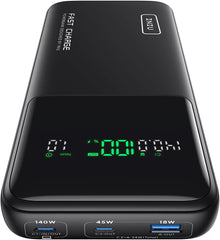
#3 INIU B64 140W | Best combo of form and function
Summary: The INIU 140W battery has a long and thinner profile than the other batteries and a very detailed display for power capacity as well as input and output use.
Pros:
- One of the better WH/oz power capacities.
- Large capacity 97.2 WH for extended battery life
- 140W input/output port for fast charging
- 2 USB-C ports, 1 USB-A port
- Power density (WH/square inch)

#4 Baseus Adaman 140 | Best lightweight 140W battery
Summary: The Baseus Adaman 140 battery is a no frills 140W battery. It has a simple digital display for capacity and provides leadership in power for weight and power for volume.
Pros:
- Best WH/oz power capacities.
- Leadership WH per square inch.
- 86.4WH sufficient for most needs
- 2 USB-C ports, 1 USB-A port
- 140W input output port supports fast 140W charging.
Cons:
- Only displays capacity.
#5 AOHI | No frills workhorse for 100W usage (tried and true)

Summary: AOHI is one of EcoSimmer's primary workhorse batteries, and it's been tested during many outings and trips. It is our favorite affordable option to work with for 100W only where capacity is the goal.
Pros:
- Holds 100Wh (30k mAH) to give you more battery life than others
- Affordable price
- Only has 1 USB-C port, so there's no confusion (many batteries have 2 USB-C ports, but with only 1 that can support 100W)
Cons:
- Display only has 4 LEDs, so it's difficult to know how much charge is remaining (each LED represents 25% charge)
Battery Reviews: Runners Up
Anker 747

Summary: The Anker 747 Power Bank was the first 100W battery on the market from World's #1 charging brand. It is dependable, reliable, and effective.
Pros:
- x2 USB-C outputs both support 100W (sufficient for powering EcoSimmer)
- Ships with Anker PowerPort III 65W USB-C charging brick (a $40+ value)
- High quality build for durability
- Largest brand in batteries and charging
- 8 LEDs show charge remaining (in 12.5% increments)
Cons:
- Expensive compared to many
- USB-C ports cannot simultaneously support powering EcoSimmer and an additional output at the same time
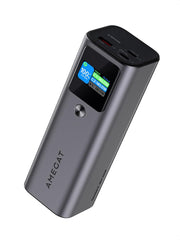
Amegat 140
Summary: The Amegat 140 battery provides a very cost effective solution while providing very good power density and a nice digital display showing capacity and status on its input and output ports.
Pros:
- Cost
- Very good WH/oz power capacities.
- 88.6WH sufficient for most needs
- 2 USB-C ports, 1 USB-A port
- 140W input output port supports fast 140W charging.
Cons:
- Not a major name brand, but this battery and other very similar ones available with Amazon.
ZMI PowerPack No. 20 Worldwide Edition
Summary: Very high-performing, the ZMI Power Pack No. 20 has a detailed display to show you exactly how much charge it has and is our favorite sleek battery without any unnecessary features.
Pros:
- Displays shows 0-100% of charge remaining (in 1% increments)
- High-quality construction and sleek design
- Battery performs flawlessly in all testing
- 25k mAH gives it a decent battery life
Cons:
- Often sold out
- Moderate price point higher than budget options
- Has 2 USB-C outputs (pro) but only 1 outputs 100W (don’t mix them up!)
- Slightly bulkier than budget options, but more compact than some high-end options
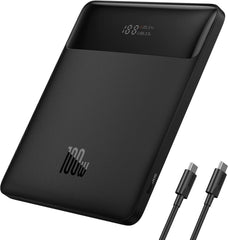
Baseus Blade 100W
Summary: The Baseus Blade is a unique choice for usage with EcoSimmer. It has the smallest power capacity of any battery on this list but has the most unique form factor. This may be best for the travelling consultant looking to charge a laptop and to make ramen in a hotel room too.
Pros:
- Unique thin formfactor makes for easy packing
- Informative display
- Easy to use
Cons:
- 100W output only
- 65Wh capacity is too small for most practical usage
Shargeek

Summary: The Shargeek battery has a transparent outer casing, letting you see the tech inside. On top of that, the detailed display that shows you its internal temp, power level (in percent), and more — a great option for the "techie" backpacker.
Pros:
- Clear housing so you can see the battery's lithium cells and circuit board
- 25.6k mAH gives it an extended battery life
- 100W input for fast charging
- 2 USB-C ports, 1 USB-A port, 1 adjustable DC port
Cons:
- Pricey
- Detailed display is small and difficult to read
Zendure Supertank Pro

Summary: Super durable and built to withstand even your most rugged adventures. Provides a detailed readout telling you exactly what's happening across all ports.
Pros:
- Detailed digital display tells you exact battery life in percent and other battery statistics
- 100W input allows for rapid charging between use
- 4 USB-C ports, 1 USB-A port
- 26.8k mAH gives it an extended battery life compared to most
Cons:
- Earlier model only supported 100W when greater than 50% of charge was remaining — be sure to opt for a newer model to use EcoSimmer
- High price point
Finding Your Own Battery
If you already have a battery or are curious if yours will work with EcoSimmer, here are some things to consider:
- Can you bring the battery on a plane? 100Wh (Watt Hours) is the “maximum” allowed battery capacity for lithium-ion batteries on airplanes. The FAA requires 100Wh USB-C lithium-ion batteries to be in carry-on baggage only — not checked bags. Both 140W USB-C and 100W USB-C batteries typically come in 80Wh to 100Wh battery capacity ranges.
- It's usually best to opt for a battery's newest generation. Newer models usually provide more information in their display, such as how much run time is left — shown in minutes or a percent. They also tend to charge faster. So, if one of your goals is to recharge via solar, newer batteries are for you.
- Weight and Dimensions — for backpacking, opting for a lightweight and compact battery is recommended. However, for lighter camping trips, the size and weight may not concern you.
- Watt Hours (Wh) — this measures battery capacity, meaning how many watts (power) can be supplied for how long. For example, a 100Wh battery can supply 100 Watts of power for 1 Hour."
- Single Port Power — this is the maximum power a single USBC port can provide. For EcoSimmer, this needs to be 140W (28V 5A) for 140W operation, or 100W (20V 5A) for 100W operation.
If you have any questions, feel free to reach out to us directly!


